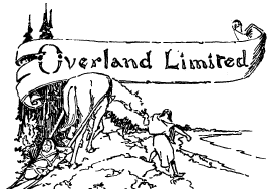|
Transportation was Limited |
|
|
"I beheld, too, in that vision |
|
|
|

|
|
|
74 |
|
|
|
|
Horn, or by the Isthmus of Darien, which took many
months. |
|
|
|
|
75 |
|
|
Gradually homesteads were
taken on the rich prairies,--towns were springing up along
the Missouri River and railways were pushing west of the
Mississippi. Men following the course of empire pictured a
great future for this new and "rapidly growing country. BUILDING OF THE RAILROAD. In 1862, an act was passed
by Congress to build a railroad from the Missouri River to
San Francisco, which met with hearty approval, and many
routes were discussed. President Lincoln finally in 1863
fixed the eastern end on the Iowa side of the river at a
point opposite the town of Omaha, and Thomas C. Durant was
given charge of the work. There was great excitement and
preparations were begun to celebrate the breaking of the
ground. The ceremonies began with prayer, then with pick and
shovel the first earth was removed amid the roar of guns
from either shore of the Missouri and shouts from the
assembled throng. Speeches were made and a great supper and
ball concluded the event. |
|
|
76 |
|
|
|
|
ing, and it was hard to find men willing to risk their
lives among the hostile Indians and endure the hardships on
the frontier. |
|
|
|
|
77 |
|
|
and Oregon trails known as the Platte Valley route, and
while markers are being placed along the trails by the
states through the efforts of Ezra Meeker, yet the great
railways have already marked the way. Contributed by Mrs. Edgar Allen.
|
|
 |
 |
 |
MARDOS COLLECTION
© 1999, 2000, 2001 for the NEGenWeb Project by Pam Rietsch,
T&C Miller